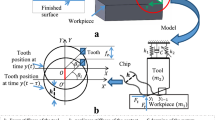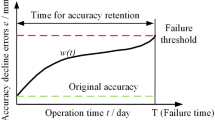Abstract
This paper serves to evaluate the dynamic performance and the cutting stability of the crankshaft grinding machine. The governing equations for the 7 degrees of freedom (DOF) lumped-mass model are formulated by the Lagrange energy method. The absolute value of the maximum negative real part of the overall dynamic compliance (MNRPODC) and the limiting chip width are the main performance indicators used to explore the structure's dynamic characteristics and the cutting stability of the grinding machine in various worktable positions. The effect on system performance of the distance between the mass center of the workpiece and the worktable module in the z direction is also analyzed. Based on the stability theory for regenerative chatter model, a computer program has been developed that utilizes the three-dimensional stability lobe diagrams of the multi-DOF system to automatically identify the stable and chatter zones. Time domain simulation of the cutting conditions is used to verify the stability lobe diagrams. Finally, an optimization analysis utilizing the particle swarm optimization method is carried out to obtain the optimal design variables. The results, in terms of |MNRPODC| or the limiting critical chip width, show improvements by a factor of 6.5 and are superior to that of the prototype machine.
Similar content being viewed by others
References
Tobias SA, Fishwick W (1958) The chatter of lathe tools under orthogonal cutting conditions. Trans ASME 80:1079–1088
Tlusty J, Polacek M (1963) The stability of machine tool against self excited vibrations in machining. ASME Production Engineering Research Conference, Pittsburgh, pp 465–474
Koenigsberger F, Tlusty J (1970) Machine tool structure. Pergamon, London
Altintas Y, Budak E (1995) Analytical prediction of stability lobes in milling. Ann CIRP 44(1):357–362
Tlusty J, Ismail F (1981) Basic nonlinearity in machining chatter. Ann CIRP 30:21–25
Schmitz TL (2002) Automatic trimming of machining stability lobes. Int J Mach Tool Manuf 42:1479–1486
Yoshimura M (1976) Analysis and optimization of structural dynamics of machine tools by a synthesis of dynamic rigidity program system. Preceedings of the 16th International Machine Tool Design and Research Conference, pp. 209–215
Yoshimura M (1977) Study on optimum design of machine structures with respect to dynamic characteristics. Bull Jpn Soc Mech Eng 145(20):811–818
Altintas Y, Weck M (2004) Chatter stability of metal cutting and grinding. CIRP Ann Manuf Technol 53(2):619–642
Hwang RM, Cha KC (2008) Construction of a prediction model for the structural stability of a surface grinder using backpropagation neural wetwork. Int J Adv Manuf Technol 37:1093–1104
Cha KC, Wang N, Liao JY (2011) Dynamics and stability analysis of the simplified model for the surface grinder in various worktable positions. J Multi-body Dynamics 225:220–234
Tlusty G (2000) Manufacturing processes and equipment. Prentice Hall, Upper Saddle River
Schmitz TL, Smith KS (2009) Machining dynamics: frequency response to improved productivity. Springer, New York
Zhang BS, Zhang S (1986) Optimization of structural parameters of crank shaft grinding machine M8260. J of Gansu U of Technol 12(4):89–101
Gawronski W (1998) Dynamics and control of structures: a modal approach. Chap 2. Springer, New York
Altintas Y (2000) Manufacturing automation: metal cutting mechanics, machine tool vibrations, and CNC design. Cambridge University Press, New York
Tarng YS, Hseih YW, Li TC (1996) Automatic selection of spindle speed for suppression of regenerative chatter in turning. Int J Adv Manuf Technol 11:12–17
Thevenot V, Arnaud L, Dessein G, Cazenave-Larroche G (2006) Integration of dynamic behaviour variations in the stability lobes method: 3D lobes construction and application to thin-walled structure milling. Int J Adv Manuf Technol 27:638–644
Tang A, Liu Z (2009) Three-dimensional stability lobe and maximum material removal rate in end milling of thin-walled plate. Int J Adv Manuf Technol 43:33–39
Song Q, Ai X, Tang W (2011) Prediction of simultaneous dynamic stability limit of time–variable parameters system in thin-walled workpiece high-speed milling processes. Int J Adv Manuf Technol 55:883–889
Kennedy J, Eberhart R (1995) Particle swarm optimization. Proc IEEE Int Conf Neural Net, Perth, Australia 1942–1945
Harris CM, Piersol AG (2002) Harris' shock and vibration handbook, 5th edn. McGraw-Hill, New York
Author information
Authors and Affiliations
Corresponding author
Rights and permissions
About this article
Cite this article
Cha, K.C., Wang, N. & Liao, J.Y. Stability analysis for the crankshaft grinding machine subjected to a variable-position worktable. Int J Adv Manuf Technol 67, 501–516 (2013). https://doi.org/10.1007/s00170-012-4501-9
Received:
Accepted:
Published:
Issue Date:
DOI: https://doi.org/10.1007/s00170-012-4501-9




